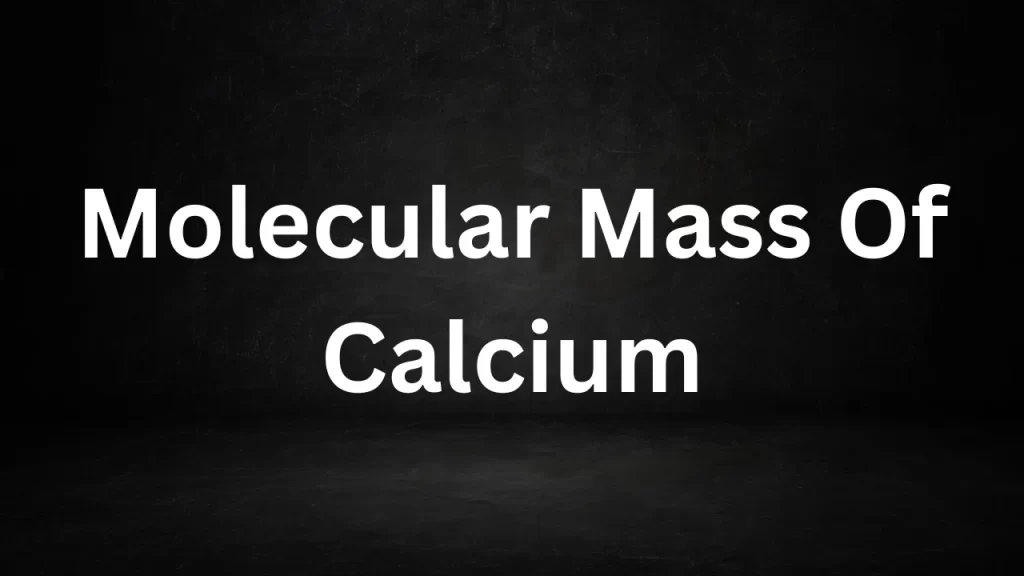Mol Mass Of Calcium: Calcium, with its symbol Ca and atomic number 20, is a fundamental element in the periodic table. It is renowned for its crucial role in biological processes, as well as its various applications in industry, agriculture, and everyday life.
Understanding the mol mass of calcium is essential for comprehending its behavior and significance in the world of chemistry. In this article, we delve into the concept of molecular mass, its calculation for calcium, and the implications of this fundamental property.

Mol Mass Of Calcium
The Nature of Calcium
Calcium is a metallic element found in group 2 (formerly group IIA) of the periodic table, along with other alkaline earth metals. It is a silvery-white, soft metal that reacts vigorously with water and oxygen, forming compounds like calcium oxide (CaO) and calcium hydroxide (Ca(OH)2). In its natural state, calcium is often found in the form of calcium carbonate (CaCO3), which makes up materials like limestone, chalk, and shells.
Importance of Molecular Mass
Mol mass, also known as molar mass or molecular weight, is the mass of a molecule or compound expressed in atomic mass units (amu) or grams per mole (g/mol). It is a fundamental concept in chemistry and has several key implications:
- Stoichiometry: Molecular mass is crucial for calculating the molar ratio of reactants and products in chemical reactions, aiding in the determination of reaction yields and limiting reagents.
- Synthesis and Formulation: Chemists use molecular mass to precisely measure and combine reactants when synthesizing compounds or formulating chemical solutions.
- Analytical Chemistry: Molecular mass is essential in the identification and quantification of compounds using techniques like mass spectrometry.
- Physical Properties: Molecular mass influences a compound’s physical properties, including melting and boiling points, density, and solubility.
Calculating the Molecular Mass of Calcium
To calculate the molecular mass of calcium (Ca), you consider the atomic mass of a single calcium atom. The atomic mass of calcium is approximately 40.08 atomic mass units (amu).
Now, let’s calculate the molecular mass of calcium (Ca):
Molecular Mass of Calcium (Ca) = Atomic Mass of Calcium Molecular Mass of Calcium (Ca) = 40.08 amu
The molecular mass of calcium is approximately 40.08 amu.
Implications of Calcium’s Molecular Mass
The molecular mass of calcium, approximately 40.08 amu, has several implications in the field of chemistry and various applications:
- Quantitative Analysis: In analytical chemistry, calcium’s molecular mass is essential for accurately determining its concentration in samples, such as in water quality testing.
- Chemical Reactions: Calcium’s molecular mass plays a key role in stoichiometric calculations for chemical reactions involving calcium compounds, ensuring precise measurements and predictions.
- Biological Role: In biology, calcium ions (Ca2+) are vital for numerous physiological processes, including muscle contraction, nerve signaling, and blood clotting.
- Industrial Applications: Calcium and its compounds are used in diverse industrial applications, including the production of steel, cement, and fertilizers, as well as in the food and pharmaceutical industries.
Conclusion
The molecular mass of calcium, approximately 40.08 amu, is a fundamental property that plays a pivotal role in chemistry and various scientific disciplines. It is indispensable for stoichiometric calculations, accurate measurements, and an in-depth understanding of calcium’s chemical and physical properties. As a versatile element with significant applications in industry, agriculture, and biology, calcium’s molecular mass continues to be a critical parameter for researchers and professionals working with this essential element.
Read More
- Molecular Weight Of Sucrose
- Molecular Mass Of Carbon
- Molar Mass Of Phosphorus
- Molar Mass of Chlorine
- Electrical Energy And Power
Frequently Asked Questions (FAQs) Molecular Mass Of Calcium
Q1: What is molecular mass or molecular weight?
A1: Molecular mass, also known as molar mass or molecular weight, is the mass of a molecule or compound expressed in atomic mass units (amu) or grams per mole (g/mol). It is a fundamental property used in chemistry to quantify the mass of chemical substances.
Q2: What is the chemical symbol for calcium?
A2: The chemical symbol for calcium is Ca.
Q3: Is calcium a metal or non-metal?
A3: Calcium is a metal. It belongs to the group of metals known as alkaline earth metals.
Q4: Why is calcium important in biology?
A4: Calcium plays a crucial role in biology as a key intracellular signaling ion. It is involved in various physiological processes, including muscle contraction, nerve transmission, blood clotting, and cell communication.
Q5: How is the molecular mass of calcium calculated?
A5: To calculate the molecular mass of calcium (Ca), you consider the atomic mass of a single calcium atom, which is approximately 40.08 atomic mass units (amu).
